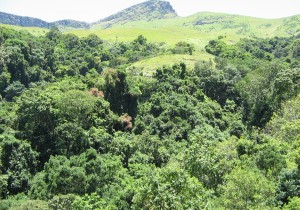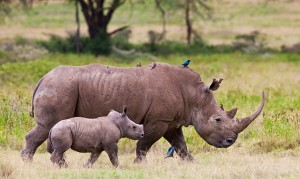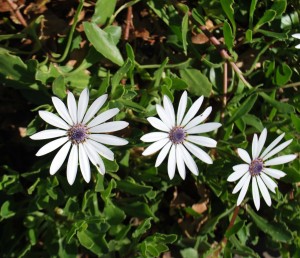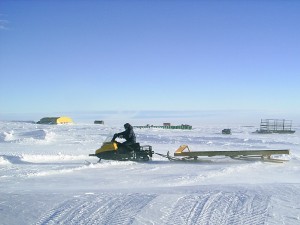CHAPTER < TWO - AN ENDURING AND SACRED ALLIANCE
“What happens to beasts will happen to man. All things are connected. If the great beasts are gone, man would surely die of a great loneliness of spirit.” North American Chief Joseph Nez Pierce
As we have seen, it is only in the last instant of geological time that our species Homo sapiens (thinking Man) has lived upon the Earth and, from earliest times, the natural world has shaped the conditions that have shaped our species. Contemporary palaeontology puts the very beginning of our story during the Miocene epoch millions of years ago, when a warm climate and extensive tropical forests provided an ideal habitat for hominoid apes.
 Over time global cooling and a resulting drier climate began to cause the lush forests that these fruit-eating, tree-dwelling apes lived in to dwindle, giving way to open grasslands and savannas. Facing extinction, the hominoid apes were forced out of the trees to forage for food on the ground. Successfully making the transition from tree-dwellers to ground foragers, over aeons of time it is believed that this distant evolutionary line evolved into the hominid species, our most distant forefathers.
Over time global cooling and a resulting drier climate began to cause the lush forests that these fruit-eating, tree-dwelling apes lived in to dwindle, giving way to open grasslands and savannas. Facing extinction, the hominoid apes were forced out of the trees to forage for food on the ground. Successfully making the transition from tree-dwellers to ground foragers, over aeons of time it is believed that this distant evolutionary line evolved into the hominid species, our most distant forefathers.
As an adaptation to roaming the vast grasslands looking for food, the knuckle-walking hominids evolved the ability to walk upright on two legs. This unique bipedal gait gave these earliest proto-humans the advantage of energy-efficient locomotion, as well as enabling them to raise their eyes to a level that could sweep above the golden grasses of the savannas. Although the mechanics of bipedalism had the disadvantage of slowing the hominids down when they were running away from the wild beasts of that epoch, it enabled them to range further and wider, becoming efficient foragers. Another advantage of the upright bodies of the hominids was the reduced likelihood of overheating on the hot, open grasslands. This allowed them to forage at a time of day when competing species rested in the cool shade of sheltering trees or overhanging rocks.
Bipedalism also freed the flexible hands of the hominids for gathering the tough seeds, roots and nuts that were their dietary mainstay. This adaptation later enabled them to carry things, throw objects and make stone tools: important evolutionary milestones. Binocular, stereoscopic, colour vision helped the hominids to judge distances, shapes and colours in their grassland environments. Over time, their arms became shorter and their brains became larger, eventually enabling the hominids to develop technical and social skills such as fire-making and co-operative hunting. In short, environmental pressures produced by a changing climate, brought natural selection to bear in a way that uniquely equipped our earliest ancestors for a life of foraging on the plains.1
Children of Nature
Apart from the obvious physical aspects of our evolutionary path, there are other deeper and more profound human characteristics that have developed in response to wild places and the companionship of other species, great and small. Our collective human psyche is intimately connected to all forms of nature, for it is within the context of the natural world of the hunter-gatherer way of life that it evolved.
Whether one is an advocate of the evolutionary theory or creationist viewpoint, it is an indisputable fact that from the time that our earliest ancestors wandered the grassy savannas of Africa, our species has evolved consciousness, intelligence, artistic expression and spirituality in response to the world of nature. For example, the ancients expressed an awareness of death, a key component of human consciousness, by covering their dead in powered red ochre. This was perhaps a belief that the colour red, being the colour of blood, had mystical life-imitating properties. They also buried their dead with stone, flint, bone and horn tools, weapons and adornments that they had made. This signified the development of ritual and a belief in an after-life.
With the wearing of ornaments such as necklaces made from mammoth ivory, ancestral people expressed self-awareness and an aesthetic sensibility. Early humans also wore cowry shells, snake bones, toucan beaks, and bats’ teeth, amongst other components taken from the world around them, as possible personal talismans against the vagaries of an uncertain existence.
 The animals of the plains on which they were dependent for food and clothing became mirrored in the images that they painted onto cave walls and fashioned out of clay, bone and reindeer antler. These were beautifully executed images of bison, horse, boar and deer; symbolically and realistically depicted, which became the first creations of human art.
The animals of the plains on which they were dependent for food and clothing became mirrored in the images that they painted onto cave walls and fashioned out of clay, bone and reindeer antler. These were beautifully executed images of bison, horse, boar and deer; symbolically and realistically depicted, which became the first creations of human art.
Out of their world of rivers, rocks and deep shaded ravines grew a need for the ancients to understand their place in that far-off world. Magic and mythology subsequently developed in response to this deep-seated human need, which was possibly played out in initiation ceremonies, the casting of spells and the sacrificing of animals for the coming seasons.
Since time immemorial, the natural world has been our species’ shaper and teacher. Our ancestors learned about the concept of time from observing the passage of the Moon through the night sky. They learned to understand the effects of the passing seasons on migrations of game. By observing nature with an innate shrewdness, the ancients also learnt the laws of leverage and gravity, and based the principles of their early traps on these laws. In this way, a branch springing back to its original position after being disturbed by a browsing animal, the weight of a heavy log thundering down a steep hillside or a hazardous branch-covered hole in the ground became the basis for the first tools of intelligence.
Over the millennia hundreds of different animal traps were invented: gravity traps, snare traps, springing-pole traps and torsion traps, all cunningly adapted to the special conditions of the surroundings and the characteristics, habits and behaviour of the prey animals. And the ingenuity expressed in the making of these traps was the first indication of a species that had gone beyond instinct into a cognitive capability that was unique on the planet. Also unique in the evolutionary history of the Earth’s creatures was the development of conceptual thought and symbolic language; capabilities that allowed for reflective discussion, the sharing of detailed information, social interaction and co-operative effort. These were elements that eventually led to the development of culture, our defining human characteristic.
 The African savannas where our first ancestors appeared thousands of centuries ago have been the cradle of our species. Over the ages, the natural world has literally shaped our bodies, minds and souls and this ancient influence has stayed with us.
The African savannas where our first ancestors appeared thousands of centuries ago have been the cradle of our species. Over the ages, the natural world has literally shaped our bodies, minds and souls and this ancient influence has stayed with us.
Warming sunlight, the smell of bushveld, a profusion of spring flowers and the sigh of the ocean as it leaves the shore; these are the healing agencies of nature that soothe our modern city senses. We are as inextricably linked to the wind whispering in treetops, to clouds scudding across a darkened sky or to the deep rumble of distant thunder as a leopard prowling a rocky mountain ledge.
Our connection to the natural world is our most profound and enduring connection and it is a mistake to think that, because our modern lives are lived predominantly glassed in away from nature and the elements, they no longer have any jurisdiction over us. In reality the opposite is true. Sensed but unseen, felt but not comprehended, elements of the natural world still exert an enormous influence over our everyday lives. And it seems that when our backs are against the wall, it is the influence of nature that we seek to calm our troubled spirits.
Winds and Rhythms
Environmental conditioning down through the ages has made us creatures of infinite subtlety and receptivity. For instance, our skins register the slightest changes in temperature, having been made sensitive to weather fluctuations by hundreds of thousands of years of adapting to the slightest shifts in cold or heat. But the temperature of our environment is not the only element of nature to affect us. Wind, that unseen ethereal shaper of continents and seas, creates a sometimes-unbearable tension in us.
A teacher I know dreads windy days for when the wind blows outside her classroom she finds that her pupils tend to be more agitated and restless than on windless days. And a golfer friend of mine told me that he has often been upset mid-swing by the unsettling effect of the wind. Windy days have also been known to affect susceptible people in ways that are more serious. Health problems such as heart attacks, ulcer perforation, embolism, thrombosis, haemorrhage and migraine have been documented to increase in populations when certain ill winds blow.
Both within our indoor, climate-controlled environments and out of doors, we have a high awareness of and a low tolerance for wind as an agent of nature. Perhaps it is due to our inherited conditioning from distant times when wind destroyed our forefathers’ flimsy shelters, leaving them vulnerable and exposed to the elements. Or perhaps it awakens deep ancient fears from aeons ago when hugely fanged predators were able to creep up to our ancestors’ caves undetected; their scents and sounds blown away by a howling wind.
Human cycles are closely reflected in the rhythms of nature.
The waxing and waning of the silver Moon corresponds to the average female menstrual cycle and human pregnancy almost perfectly reflects the elapse of nine planetary months. Our daily body rhythms are synchronised according to the rising and setting of the Sun and the desynchronisation of this internal biological clock can affect us greatly, both physically and psychologically.
 Scientists living and working in the freezing Antarctic wastes over the dark months of winter have been known to suffer from a condition called Antarctic syndrome. As the days and months pass during which they are holed up in their bases, sometimes unable to venture outside for days at a time because of shrieking blizzards, those affected by Antarctic syndrome become paranoid, antisocial, and sometimes even violent. Some people have even been known to exhibit a type of uncharacteristic madness. One base commander in the Antarctic was suspected of setting fire to and destroying his own base, a potentially disastrous act in an environment as frigidly unforgiving as the frozen south. This same base commander had also less seriously, but just as illogically, stolen his crew’s toothpaste at every opportunity.
Scientists living and working in the freezing Antarctic wastes over the dark months of winter have been known to suffer from a condition called Antarctic syndrome. As the days and months pass during which they are holed up in their bases, sometimes unable to venture outside for days at a time because of shrieking blizzards, those affected by Antarctic syndrome become paranoid, antisocial, and sometimes even violent. Some people have even been known to exhibit a type of uncharacteristic madness. One base commander in the Antarctic was suspected of setting fire to and destroying his own base, a potentially disastrous act in an environment as frigidly unforgiving as the frozen south. This same base commander had also less seriously, but just as illogically, stolen his crew’s toothpaste at every opportunity.
Buried Alive
An experiment to record the natural rhythms of human life was conducted on French volunteer Michel Siffre at Midnight Cave in Texas, United States. At the start of the experiment Michel was lowered alone into this vast underground cavern where he was to live disconnected from the sun for a period of six months. His home within the cave was a tent perched on a wooden platform and through a system of switching on and switching off of lights, he was able to create his own day and night out of the unchanging blackness of the cave. Geologist Michel Siffre found that his normal 24-hour day of sleep and wakefulness stretched into cycles lasting as long as 51¾ hours.
After a period of time in the deep darkness and unremitting silence of the underground cave, profound physical and psychological changes began to affect Michel. On his 86th day, he considered committing suicide and some time afterwards he noted that his manual dexterity and mental faculties had deteriorated badly. His hands became so slow and clumsy that he found it difficult to perform simple tasks such as stringing beads. He also found that his memory deserted him almost as quickly as thoughts formed in his mind and months after his isolation in Midnight Cave, Michel still suffered from the effects of his incarceration. His eyesight had weakened considerably and he had developed a chronic squint. He was also plagued by severe memory lapses and he later suffered from psychological problems.
Human beings did not evolve to live in dark, silent places away from the influence of natural light and sound. Eighteenth century philosopher, Jean-Jacques Rousseau, wrote, “Complete silence induces melancholy, it is an image of death.” Perhaps in that dark underground cavern, shut away from sunlight and the sound of birds twittering cheerfully in the treetops or the boom of distant thunder, Michel Siffre’s spirit died a little. Certainly his incarceration in Midnight Cave profoundly changed him and he came out of the cave a different man from the one who had first gone into it. Silence and darkness had seemed to wound his spirit. So had the loneliness of his brief existence without the companionship of other living creatures…